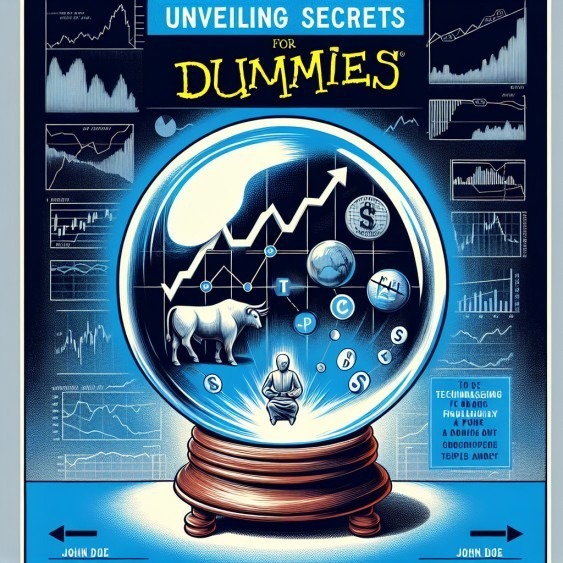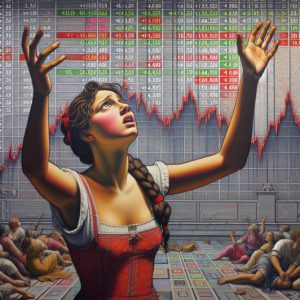
Demystifying Technical Analysis for Dummies: Unlocking Secrets
Updated May 01, 2024
Technical analysis of financial markets is an approach that involves analyzing past price data to predict future price movements. This approach is based on the assumption that past price movements can provide valuable insights into the market’s direction. Technical analysis relies on charts, statistical indicators, and other tools to identify trends and patterns in the market.
Common Price Chart Patterns Used in Technical Analysis
Essential Technical Indicators in Technical Analysis
Technical analysis is a critical tool for traders to predict future market movements based on past price actions. Among the various techniques, specific price chart patterns stand out for their reliability and widespread use. Here, we focus on a few key patterns and fortify the discussion with insights from a renowned technician other than John Murphy.
Head and Shoulders: This pattern is a classic reversal indicator. It features two peaks (shoulders) surrounding a higher peak (head), with a ‘neckline’ drawn at the lows of the troughs between these peaks. A break below the neckline confirms the pattern, suggesting a potential trend reversal from bullish to bearish.
Double Top and Double Bottom: These patterns signal trend reversals. A double top, appearing at the end of an uptrend, suggests a move to a downtrend upon completion. Conversely, a double bottom, found at the end of a downtrend, indicates a potential shift to an uptrend.
Triangles and Wedges: Both patterns are crucial for indicating continuation or reversal. Triangles can be ascending, descending, or symmetrical, showing a continuation of the current trend. Wedges, with both sides sloping in the same direction, can indicate either a trend continuation or reversal based on the slope direction.
Cup and Handle: This bullish continuation pattern suggests an upward trend resumption. It resembles a cup with a handle, where the cup represents a period of consolidation, and the handle indicates a slight downward drift before a breakout above the handle’s upper trendline.
Rounding Bottom: Known for signalling long-term trend reversals, this pattern appears as a gradual “U” shape, indicating a shift from a bearish to a bullish market. It is characterized by a slow initial decline followed by a stabilization and an upward trend as market conditions improve. In order to enhance the understanding and application of these patterns, insights from technicians like Martin Pring can be invaluable. Pring, known for his detailed analysis of market trends and technical indicators, emphasizes the importance of understanding market psychology and technical signals.
His work complements the practical application of these patterns, providing a deeper insight into when and why these patterns might indicate significant market moves. In summary, mastering these chart patterns, supported by expert analysis from technicians like Pring, can significantly enhance a trader’s ability to make informed decisions in the stock market. These patterns help predict market movements and plan strategic entries and exits, which are crucial for successful trading.
The Role of Mass Psychology in Financial Markets
Mass psychology is integral to understanding financial markets, as it influences the collective behaviour of market participants. This field examines how emotions, biases, and beliefs drive market movements, providing traders with insights to anticipate trends and make informed investment decisions.
Influence of Collective Emotions:
The collective emotions of its participants heavily sway market sentiment. For instance, widespread optimism can lead to increased buying activity during bullish phases, often pushing prices higher than their intrinsic values. Conversely, pervasive fear can lead to excessive selling in bearish markets, causing prices to fall below their fundamental worth. Recognizing these emotional extremes is crucial for identifying potential market turning points.
Integration with Technical Analysis:
Technical analysis and mass psychology are complementary tools. By analyzing price patterns and market trends, traders can gauge the emotional state of the market. For example, a sudden spike in volume alongside a price peak might indicate euphoria, suggesting a possible reversal if supported by other technical indicators.
Theoretical Foundations by Gustave Le Bon and Emile Durkheim:
Gustave Le Bon’s theories on crowd psychology highlight how individual behaviours are influenced by group dynamics, which is directly applicable to market movements. According to Le Bon, crowds operate under a group mind that can behave emotionally and irrationally, a phenomenon often observed during market bubbles and crashes.
Emile Durkheim’s concept of collective consciousness further enriches this analysis. Durkheim argued that societies are bound by shared beliefs and values, which can be seen in how market trends develop based on common investor expectations and reactions to economic events. His idea that social facts, including collective sentiments, should be considered as things in themselves suggests that market sentiments are not just fleeting reactions but integral to market dynamics.
Practical Application:
The 2008 Financial Crisis: A Case Study in Mass Psychology
The 2008 financial crisis provides a striking example of how mass psychology can drive market behaviour. As the crisis unfolded, widespread panic led to a massive market sell-off, exacerbated by the fear and uncertainty dominating investor psychology. Astute traders who recognized these signs of collective fear could have predicted further downward movement and adjusted their strategies accordingly.
Technical analysis tools like sentiment indicators, put/call ratios, and volatility indices can help gauge the prevailing market psychology. In 2008, these indicators would have flashed extreme fear readings, signalling an oversold market ripe for a bounce or trend reversal. **Contrarian traders could have used this as a buying opportunity, going against the herd mentality.**
Machiavelli understood how fear could be used to manipulate the masses. In 2008, fear was the dominant emotion driving investor behaviour and decision-making. As Machiavelli described leaders controlling their followers, savvy market operators could have capitalized on this fear.
Freud’s theories on crowd psychology, such as people’s tendency to regress to a more primitive state in groups, help explain the irrational exuberance and subsequent panic seen in financial bubbles and busts. The 2008 crisis showcased this herd mentality at an extreme.
By combining technical analysis with an understanding of crowd psychology informed by thinkers like Machiavelli and Freud, traders in 2008 could have developed effective strategies, such as:
1. Using TA to identify oversold fear conditions and initiate contrarian long positions
2. Monitoring mass psychology to anticipate further selling pressure and wait for capitulation
3. Recognizing the fear and irrationality driving the crisis to remain objective and avoid getting caught up in the panic
4. Controlling one’s emotional responses to the market volatility to make clear-headed decisions
Contrarian Strategies:
Contrarian investing is another area where mass psychology plays a crucial role. This approach involves going against prevailing market sentiments based on the assumption that the crowd often gets it wrong at critical turning points. By adopting a contrarian stance, investors aim to capitalize on the market’s tendency to overreact to news, potentially securing profits by going against the grain.
For example, during the dot-com bubble, contrarian investors would have looked for signs of excessive optimism and overvaluation in tech stocks, potentially shorting these stocks or looking for undervalued sectors as alternative investments. This strategy often requires a robust understanding of technical indicators and market psychology to execute effectively.
Long-Term Trading with Technical Analysis:
Long-term or position traders also benefit from integrating technical analysis with an understanding of mass psychology. Using longer-term charts, such as weekly and daily setups, these traders can identify broader market trends that reflect underlying mass behaviours. For instance, a long-term trader might use a Rounding Bottom pattern, which indicates a gradual shift from a bearish to a bullish market, as a signal to enter a long position. This pattern, characterized by a slow initial decline followed by a stabilization and an upward trend, can be a powerful indicator of a significant market turnaround.
Experts like Martin Pring, renowned for his work on market momentum and technical analysis, emphasize the psychological aspects of market cycles, adding depth to this discussion. Pring’s analysis suggests that investor psychology cycles through phases of optimism and pessimism, which can be predicted using key technical indicators like the KST (Know Sure Thing) oscillator. This tool, developed by Pring himself, is designed to gauge the momentum of the market, which often reflects the collective emotional state of its participants.
Pring’s approach aligns with both contrarian strategies and the use of technical analysis, providing a comprehensive framework for understanding and exploiting market sentiment shifts. For example, when the KST indicates an overbought market, a contrarian might see this as a signal to prepare for a potential downturn, contrary to the prevailing market optimism. Conversely, according to the KST, an oversold market could signal a contrarian to anticipate a market recovery despite prevailing pessimism.
Exploring Sources in Technical Analysis of the Financial Markets
Mastering technical analysis requires significant time, patience, and continuous learning. Traders can access helpful resources online to develop their skills:
TradingView offers free essential TA tools, charts, and a social network for traders to share insights. It has over 30 million monthly active users and covers 100,000+ assets across global markets.
– StockCharts: Provides free TA tools and charts. Used by over 1.5 million investors and traders monthly.
However, these are just tools. Traders must deeply understand the market and correctly interpret patterns. Key skills include:
1. Proficiency in data manipulation and visualization
2. Strong analytical abilities and attention to detail
3. Deriving actionable insights from complex datasets
The Role of Patience and Discipline
Patience and discipline are essential virtues for successful traders. Developing these skills is challenging but crucial. When a carefully analyzed trade fails to produce expected results, traders must:
1. Re-examine their analysis to identify what has changed
2. Determine if their original rationale remains valid
3. Make prudent decisions to hold, adjust, or exit the position
Conclusion
Technical analysis and mass psychology are valuable tools for traders looking to make profitable investments in the financial markets. Multi-time frame analysis and the consideration of mass psychology can help traders identify key trends and market sentiment, making it easier to implement technical analysis effectively.
However, traders must be disciplined and patient when implementing these strategies, as they require a deep understanding of the market and the ability to interpret charts and patterns correctly. By allocating time to learn and continuously developing their skills, traders can make profitable investments and achieve long-term success in the financial markets.
Articles of Interest:

Psychological Manipulation Tactics: Your Recognition & Defense Guide

Is Value Investing Dead? Shifting Perspectives for Profit

What Will Happen When the Stock Market Crashes: Time to Buy

Dogs of the Dow 2024: Barking or Ready to Bite?

The Trap: Why Is Investing in Single Stocks a Bad Idea?

How Can Stress Kill You? Unraveling the Fatal Impact

Financial Mastery: Time in the Market Trumps Timing

Investment Pyramid: A Paradigm of Value or Risky Hail Mary?

Quantitative Easing: Igniting the Corruption of Corporate America

Blooms and Busts: Navigating the Tulip Bubble Chart Phenomenon

Uranium Market Outlook: Prospects for a Luminous Growth Trajectory

Stock Investing for Kids: Surefire Path to Success!

An Individual Who Removes the Risk of Losing Money in the Stock Market: A Strategic Approach

Palladium Forecast: Unveiling the Stealth Bull Market



